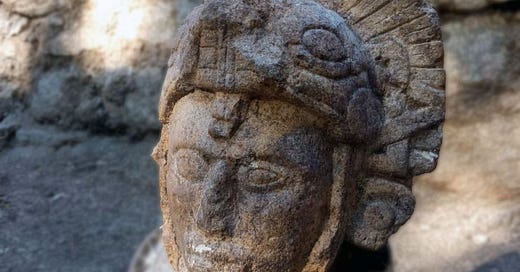🧐 Ancient Beat #87: Human parenting, 100,000 coins, and a 100-mile network of sites
Hey everyone, welcome to issue #87 of Ancient Beat. Busy week! Or is it just me? Let’s cut the chit chat and get right into it. 😀
Here’s the latest ancient news. 👇
🗞 Ancient News: Top 5
Satellite Images Bring Serbia’s Hidden Bronze Age Megastructures to Light — A few weeks ago, I covered hundreds of Roman sites found via satellite. Now, over one hundred 3,600-year-old structures have been found in Serbia via Google Earth. The sites form a belt stretching about 100 miles along the Tisza River. It is thought that they represent a network of settlements that took part in the bronze trade, but it’s also possible that they’re simply cattle pens or gathering places. If they were settlements, each one would have held a handful of extended families. On the ground, the team of researchers found plenty of artifacts, from stone grinders to pottery to animal bones, all on the surface due to decades of plowing. There was also evidence of defensive earthworks (walls and ditches). By 1200 BCE, the enclosures were abandoned, and in some cases, deliberately dismantled, with ditches filled and walls toppled.
Homo Naledi Probably Didn’t Bury their Dead or Make Rock Art After All — You might remember that in issue #64, I covered the incredible discovery that Homo naledi may have buried their dead 300,000 years ago. Well, a new study refutes this. It’s very difficult to get to the alleged burial chamber in the cave system, so it’s not that new evidence has come to light. The response is essentially that A. The bones were not articulated, they were scattered, which means it’s unlikely that anything was placed on top of the bodies to protect them, and this makes it less likely to be a grave. And B. the dating of the cave art seems to have used more guesswork than scientific technique. For me, personally, I see no issue with the idea that Homo naledi were capable of burying their dead (and making art). On the contrary, I think that’s much more likely than the idea that all of the remains made their way to their current positions via drainage and/or carnivores. But I do agree that more investigation is required and I’m excited to learn more!
Maya Warrior Statue with Serpent Helmet Discovered at Chichén Itzá — The head of a statue was discovered in the basement of a temple at Chichén Itzá in Mexico. It depicts a warrior with a serpent’s head as a helmet and a feathered headdress. It is about 13 inches tall and dates to 1,000 years ago.
Incredible Trove Of 100,000 Ancient Coins Tied Together In Bundles Uncovered In Japan — Lots of coins have been found lately, and this discovery takes the cake. An incredible 100,000+ coins were found in Japan. They were tied together in 1,060 100-coin bundles. Some of the coins are from China and, though only a small number of the coins have been analyzed so far, the oldest is currently a Ban Liang coin from 175 BCE — these were the first coins minted when China was unified by the first Emperor, Qin Shi Huang. The most recent coin analyzed so far is from 1265 CE, so unless a newer coin is found, the cache is thought to be from the Kamakura Period (1185-1333). Why the cache was buried remains a mystery.
Hunter-Gatherer Approach to Childcare Suggests that the Key to Mother and Child Well-Being may be Many Caregivers — According to a new study, humans are “evolutionarily primed” for high levels of physical contact, care, and personal attention as children. The study looked at modern hunter-gatherers to understand how humans have been raising kids for the vast majority of human existence. According to Nikhil Chaudhary, “For more than 95 percent of our evolutionary history, we lived as hunter-gatherers. Therefore, contemporary hunter-gatherer societies can offer clues as to whether there are certain child-rearing systems to which infants, and their mothers, may be psychologically adapted.” The researchers found that infants receive attentive care and physical contact for about nine hours per day. And not just from their parents, but from multiple other caregivers in the community as well. Older children also played a big role. The study concludes that this degree of contact and care is key to the well-being of both mother and child.
That’s it for the free Top 5! If you’re a free subscriber, sign up for the paid plan for another 19 stories and 7 recommended pieces of content covering ship graves, ancient skull surgery, unique ivory objects, obsidian mining, and Scandinavian agriculture.
Until next time, thanks for joining me!
-James
Twitter: @jamesofthedrum
P.S. If you like what you’re seeing, please consider forwarding it to a friend. It would mean a lot! 🙏
P.P.S If you want access but it’s a little too steep for you right now, just shoot me an email — I want this to be accessible.
P.P.P.S. Paid members, read on!
🗞 Ancient News: Deep Dive
Keep reading with a 7-day free trial
Subscribe to Ancient Beat to keep reading this post and get 7 days of free access to the full post archives.




